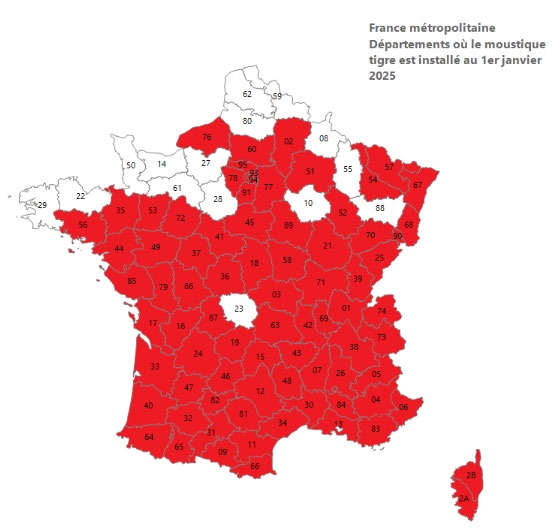Translation Google
On the occasion of the launch of reinforced surveillance of dengue, chikungunya and Zika in metropolitan France, health authorities are reminding people of the importance of protecting themselves from mosquito bites.
Every year, May 1st marks the beginning of the enhanced period of surveillance for arboviruses, such as dengue, chikungunya, and Zika, in metropolitan France, and the implementation of vector control measures by health authorities. This system makes it possible to identify and closely monitor the circulation of these viruses in metropolitan France, and thus limit their transmission.
Published on May 15, 2025
Press contacts
Health Crisis Center - Ministry of Labor, Health, Solidarity and Families
alertes-presse@sante.gouv.fr
Public Health France
presse@santepubliquefrance.fr
The tiger mosquito is now present in 84% of metropolitan departments
Introduced into mainland France in 2004, the tiger mosquito ( Aedes albopictus ) continues its rapid expansion. As of January 1, 2025, it is present in 81 departments, or 84% of metropolitan departments. The newly colonized departments in 2024 are Marne, Haute-Marne, and Haute-Saône.
Source DGS, SI-LAV, as of January 1, 2025.
This mosquito is a vector of dengue viruses , but also chikungunya and Zika .
In 2024, metropolitan France recorded a record number of dengue cases, both imported (contracted during a stay in a tropical zone) and indigenous (contracted in mainland France). Since the beginning of 2025, Public Health France has already recorded more than 1,100 imported cases of dengue fever and more than 900 imported cases of chikungunya. Beyond the risk of dengue circulation, the beginning of 2025 is indeed marked by a particularly increased risk of importation and circulation of the chikungunya virus in mainland France due to the ongoing epidemics in the territories of Réunion and Mayotte. This situation raises fears of the establishment of indigenous circulation of these diseases in the coming weeks.
All of these elements remind us of the importance of adopting the right actions to protect ourselves from bites, fight against the proliferation of mosquitoes and limit the transmission of diseases.
Health authorities, health professionals and vector control stakeholders fully mobilized
Throughout the year, government departments, national and regional health agencies, local authorities and vector control operators are fully mobilized to limit the risk of epidemics linked to mosquito-borne diseases.
Surveillance is being reinforced during the period of activity of the tiger mosquito in mainland France (from 1 May to 30 November), thanks in particular to raising awareness among health professionals about diagnosis and reporting cases from the start of the season, allowing regional health agencies to take vector control measures around infected people in order to limit the risk of local transmission.
The fight against these so-called vector-borne diseases is a public health priority for the Ministry of Health and Access to Care.
Mosquito control is everyone's business!
Combating mosquito bites means combating the transmission of potentially serious diseases. While no single measure is 100% effective, it is the sum of individual and collective measures that can reduce the transmission of these diseases.
Simple actions to prevent the proliferation of mosquitoes
To limit the risk of mosquito proliferation and establishment, everyone must ensure they combat mosquito breeding sites, which are conducive to their development. To do this, it is important to eliminate stagnant water in and around habitats (under pots, tarps, waste, gutters, etc.).
Avoiding being bitten means protecting yourself and also avoiding transmitting the disease.
There are ways of personal protection, such as wearing long, loose clothing, using repellents, and installing mosquito nets.
An infected mosquito can, a few days later, bite other people who will in turn be infected by the virus, leading to the appearance of the first indigenous cases which could cause an epidemic: it is therefore essential to protect yourself and others.
Follow the advice for people staying in risk areas
For people traveling to and returning from an area where mosquito-borne diseases are common (including Réunion, Mayotte, Martinique, Guadeloupe and Guyana, but also in many tropical countries), it is strongly recommended to:
If you experience symptoms (joint or muscle pain, headache, rash, conjunctivitis, with or without fever) after a bite, it is important to consult a doctor immediately, specifying that you have been in an area where the chikungunya, dengue or Zika viruses are circulating.
To find out more
On the occasion of the launch of reinforced surveillance of dengue, chikungunya and Zika in metropolitan France, health authorities are reminding people of the importance of protecting themselves from mosquito bites.
Every year, May 1st marks the beginning of the enhanced period of surveillance for arboviruses, such as dengue, chikungunya, and Zika, in metropolitan France, and the implementation of vector control measures by health authorities. This system makes it possible to identify and closely monitor the circulation of these viruses in metropolitan France, and thus limit their transmission.
Published on May 15, 2025
Press contacts
Health Crisis Center - Ministry of Labor, Health, Solidarity and Families
alertes-presse@sante.gouv.fr
Public Health France
presse@santepubliquefrance.fr
The tiger mosquito is now present in 84% of metropolitan departments
Introduced into mainland France in 2004, the tiger mosquito ( Aedes albopictus ) continues its rapid expansion. As of January 1, 2025, it is present in 81 departments, or 84% of metropolitan departments. The newly colonized departments in 2024 are Marne, Haute-Marne, and Haute-Saône.

Source DGS, SI-LAV, as of January 1, 2025.
This mosquito is a vector of dengue viruses , but also chikungunya and Zika .
In 2024, metropolitan France recorded a record number of dengue cases, both imported (contracted during a stay in a tropical zone) and indigenous (contracted in mainland France). Since the beginning of 2025, Public Health France has already recorded more than 1,100 imported cases of dengue fever and more than 900 imported cases of chikungunya. Beyond the risk of dengue circulation, the beginning of 2025 is indeed marked by a particularly increased risk of importation and circulation of the chikungunya virus in mainland France due to the ongoing epidemics in the territories of Réunion and Mayotte. This situation raises fears of the establishment of indigenous circulation of these diseases in the coming weeks.
All of these elements remind us of the importance of adopting the right actions to protect ourselves from bites, fight against the proliferation of mosquitoes and limit the transmission of diseases.
Health authorities, health professionals and vector control stakeholders fully mobilized
Throughout the year, government departments, national and regional health agencies, local authorities and vector control operators are fully mobilized to limit the risk of epidemics linked to mosquito-borne diseases.
Surveillance is being reinforced during the period of activity of the tiger mosquito in mainland France (from 1 May to 30 November), thanks in particular to raising awareness among health professionals about diagnosis and reporting cases from the start of the season, allowing regional health agencies to take vector control measures around infected people in order to limit the risk of local transmission.
The fight against these so-called vector-borne diseases is a public health priority for the Ministry of Health and Access to Care.
Mosquito control is everyone's business!
Combating mosquito bites means combating the transmission of potentially serious diseases. While no single measure is 100% effective, it is the sum of individual and collective measures that can reduce the transmission of these diseases.
Simple actions to prevent the proliferation of mosquitoes
To limit the risk of mosquito proliferation and establishment, everyone must ensure they combat mosquito breeding sites, which are conducive to their development. To do this, it is important to eliminate stagnant water in and around habitats (under pots, tarps, waste, gutters, etc.).
Avoiding being bitten means protecting yourself and also avoiding transmitting the disease.
There are ways of personal protection, such as wearing long, loose clothing, using repellents, and installing mosquito nets.
An infected mosquito can, a few days later, bite other people who will in turn be infected by the virus, leading to the appearance of the first indigenous cases which could cause an epidemic: it is therefore essential to protect yourself and others.
Follow the advice for people staying in risk areas
For people traveling to and returning from an area where mosquito-borne diseases are common (including Réunion, Mayotte, Martinique, Guadeloupe and Guyana, but also in many tropical countries), it is strongly recommended to:
- Find out before departure about diseases circulating in the destination areas;
- Protect yourself against mosquitoes during a stay in these risk areas and for up to three weeks after your return, to avoid transmitting a disease to your loved ones via mosquitoes.
If you experience symptoms (joint or muscle pain, headache, rash, conjunctivitis, with or without fever) after a bite, it is important to consult a doctor immediately, specifying that you have been in an area where the chikungunya, dengue or Zika viruses are circulating.
To find out more
- Report on the surveillance of dengue, chikungunya and Zika in mainland France in 2024
- In territories and countries at risk:
- consult the travel advice pages of the France Diplomatie website or those of the Pasteur Institute in Lille .
- For overseas territories, consult the website of the relevant ARS.
- Mosquitoes as vectors of disease | sante.gouv.fr
- Dengue, Chikungunya, Zika: From Prevention to Reporting | santepubliquefrance.fr

Comment